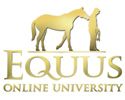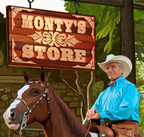I've just spent the last 3 days at Equidays, a horse event here in NZ. I've watched several practitioners starting horses or problem solving, and they all place a lot of emphasis on getting bend in the horses body. For safety and calming the horse, they say this is a basic, foundational skill that we should be practising with our horses right from day one. If the horse responds to your request to bend its body, or yield the hind quarter, then you can stop them bolting, rearing, bucking etc. However, after being a member of the Monty's online university for about 8mths now, I've realised that Monty doesn't seem to do any of this at all (apart from being a more advanced skill that is taught later as a leg yield). Is this because there is a reason not to? or simply that he hasn't found it to be necessary?




.
Monty uses Join up to create trust & relaxation so the horse is able to naturally adapt to new situations, whether it be carrying a rider or facing some other nemesis of life. The ability to 'read' the individual horse ( meet its needs ) allows the trainer to work within the horses own understanding limits. Instinct causes flight animals to run ( bolt ) or fight ( rear, buck, kick, bite ) when they perceive danger & suffer stress. By creating enough trust for the horse to override its natural instinct to react, to ' give the trainer a chance ' allows horse & human to bond into a partnership, vastly reducing the likelihood of mishap or injury to either one of them. When horses progress into more advanced training, the ability to relax & bend its body greatly enhances performance & lessens the incidence of injury by eliminating unnatural physical strain on the body ( imbalance in single line lunging ).
.
My horse Apollo was a teenager when I got him. He'd had a lower back injury ( vertebrae fused together ). He was a most willing partner & threw himself enthusiastically into many activities despite being ' cold backed '. Whenever I mounted for the first time I needed to stay standing in the stirrups, keeping my weight over his withers & let him walk off otherwise he ' dipped down - presumably in pain. I always mounted the first time from a raised level ( mounting block, gate, Landrover bumper, fallen tree trunk ). He always willingly stood, in the knowledge that I would put my weight on his shoulders & let him work his back up to the task - walking maybe 30 metres. Thereafter I could mount from the ground, if necessary, without causing him any problem. However, he cornered like a motorbike, adapting to his disability wonderfully well - but no use for dressage! AND THERE WE HAVE THE KEY!!! The human adapting to the situation presented so the horse is allowed to understand the task & then participate according to their natural abilities.
.
There are many trainers who do not employ violence but some use more coercion & therefore less understanding. Perhaps some have not yet acknowledged that, like humans, all horses are individuals & so there can be no ' one fits all ' method/timescale. Monty puts emphasis on the horse understanding & accepting, using gentle pressure to guide each horse, AT ITS OWN PACE, to the training goal. I guess it all comes down to whether you LOVE horses & the incredible power they share with us or you just want the power the horses have. Perhaps this is a suitable subject for Montys Challenge? Cheers, Jo.
Thank you Jo
Bud
Thank you!
Bella
So relieved and happy for you and your horse-partners that it turned out all safe and good.
The trust bond is true and strong between you all. A pleasure to read how you calmly handled the frightening situation. I celebrate with you.
All the best, Bella